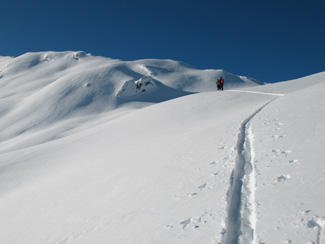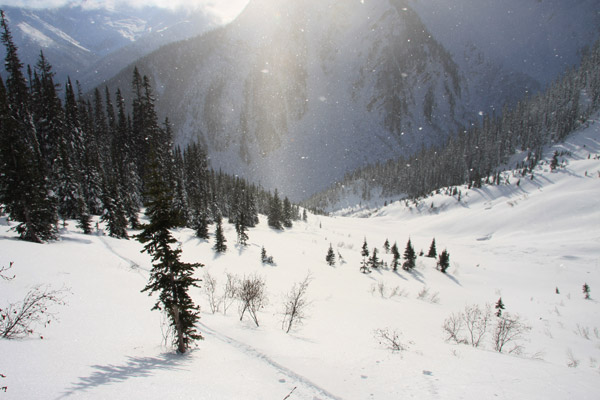Since the end of the last season the System underwent significant changes that were introduced to public at the beginning of this one.
Anyone that skies or skied at Rogers Pass most likely knows about the Winter Permit System that is in place to keep the winter recreating public safe, however, now the rules got a bit more strict and some new restricted areas were created.
What is the Winter Permit System in short?

In other words, it is in place to make sure no one will enter areas when they are under gunfire via avalanche control work that is conducted to keep the transportation corridor open.
The Winter Permit System divides the park into three types of areas:
- Winter Prohibited Areas are closed to visitors all winter.
- Winter Restricted Areas are where permit holders can only ski here on days when the area is posted as open.
- Winter Unrestricted Areas of the park are open to visitors all winter. No permit is required.
How does it work and what is new?
From a skier point of view the permit system used to work this way:
Any time you or your group intended to ski in a winter restricted area you had to drive up to Rogers Pass Center, find out what’s open and what is not, and apply for a permit.
Then one of you filled out the permit and off you went to where it was open – meaning the area was not controlled by avalanche professionals for that day.
Since the changes were introduced this process changed a bit. In some ways it means more hassle, more restrictions but in some ways it makes things easier and makes rules more clear.
Now there are two ways how to apply for a permit to a winter restricted areas:
1. The old way with a change:
As before, you drive up to Rogers Pass Center and fill out the permit there. But as of now, everyone in the group needs to fill out a permit and sign a waiver. A bottom portion (stub) of the permit of each one’s permit needs to be placed on the dash of your car. The bigger slip goes with you on the trip.
2. The new way:
You apply for an Annual Winter Permit – for free – at the Rogers Pass Center (RPC) and you will be set for the rest of the winter without needing to drive up to RPC each time you want to ski in a restricted area. To get your Annual Winter Permit you need to sign couple of waivers and sit through one of the orientation sessions that are being held twice a week at RPC.
The Annual Winter Permit consists of two “credit card like” looking cards. One has a photo of you on it and you carry it with you on your trips. The other one needs to be placed on the dash of a car that is used to access the area.
Of course, you can access a restricted area only when it’s open. To find out what is open you can either visit Parks Canada website or call this number: 1-250-837-SKIS (7547).
Benefits
An obvious benefit for those that ski the Pass regularly or couple of times a season is that they don’t have to drive up to the Pass every time they want to ski in a restricted area.
Hassles
For those that ski the Rogers Pass only a few days per season it means driving up to RPC to get a permit any time they want to ski in a restricted area. And each member of the group has to fill out the permit and sign a waiver, each and every time.
New restricted areas
There are three new restricted areas that are very popular locations – McGill, Cheops North, and Grizzly Shoulder. That means that you will have to apply for a permit any time you intended to ski here, unless of course you have the annual permit.

Why all these changes?
Based on Parks Canada website: “Changes to the Winter Permit System are based on concern for public safety – due to expanding terrain use by backcountry recreationists and the operational need to separate recreation activities from avalanche control actions. Boundaries to Winter Restricted and Prohibited areas have been adjusted in order to firmly apply accepted standards of 1000 metre standoff from artillery targets.”
In other words, until now skiers were exposed to the same danger but now that is no longer acceptable 🙂
Now more seriously – it is a concern now because people are skiing at places they never skied before and the highway avalanche program professionals feel that there would be potential accidents if these changes weren’t made.
Also, a part for initiating these changes was how backcountry users were dealing with railway tracks – crossing them or just walking on them.
By law, crossing Canadian Pacific Railways tracks is trespassing on CP property. Therefore, some crossings and access points have been evaluated and re-established. And make sure to not walk on tracks at all. You can walk parallel to them but at least 16m away from them.
What you should do? What others think?
Parks Canada is making a great effort to make sure that the public has access to as much terrain in Glacier National Park as possible. Therefore, we should all behave in such ways that won’t compromise future use of this great terrain by getting us shut out via some highway corridor safety or CP property issues. The priority is on safe public travel and transportation, so be good guests for the sake of all of us.
Understandably, some local or frequent skiers to Rogers Pass feel that something is being imposed on them that restricts them in a big way. I might agree in some ways, however, I think we should give the new changes a chance and re-evaluate them at the end of this season.
What do you think? Want to learn more?
Changes to the System is a bit of a hot topic among the Rogers Pass winter users these days. Therefore, you are welcome to express your opinion about this topic and discuss it in the comments below. It would be interesting to see what people thing.
To learn more details about the changes in Winter Permit System you can visit Parks Canada website – Winter Permit System.


Leave a Reply